Health & Safety:
CHEMICALS/DUSTS
Updated 01/06/2023

Glass Artists use a variety of chemicals and materials that can be harmful. Always know the toxicity of chemicals and materials you are working with and how to protect yourself.
Material Safety Data Sheets
Best source of information about a chemical is the MSDS:
- Material Safety Data Sheet
- Must be provided by the manufacturer
- Not all MSDSs are of good quality! Look for MSDSs from major manufacturers. Make sure they are recent (<5 years).
- Manufacturer’s in most countries are required to provide a MSDS with their products or provide one upon request.
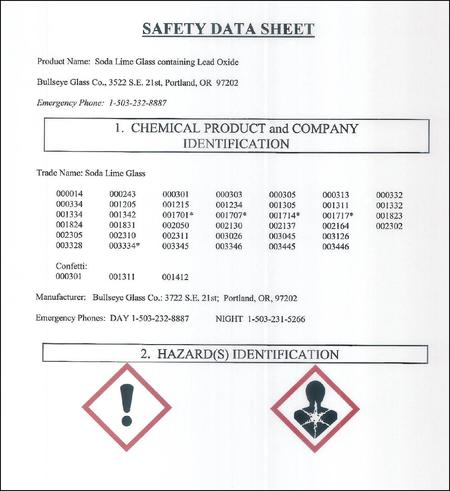
A MSDS will provide you with information about the product:
- Hazardous Ingredients
- Physical & Chemical Data
- Fire/Explosion
- Health Hazard Data
- Route of Exposure
- Exposure Control
- Personal Protective Equipment
Where to find MSDS’s on the Internet:
- Check the chemical manufacturer’s website
- Google the chemical name and/or manufacturer
You need to understand the potential effects of the chemical:
Acute:
- Reaction is immediate
- Example – Acetone defats the skin (dries the skin), arsenic can poison you
Chronic:
- Reaction is cumulative and can take years to be seen
- Example – lung disease from breathing refractory fibers, neurologic disorders from lead exposure
Possible routes of exposure:
- Inhalation (most common)
- Dermal (skin) Contact
- Ingestion
There are exposure limits for many chemicals:
OELs – Occupation Exposure Limits:
- Developed by OSHA (PEL – Personal Exposure Limit), ACGIH (TLV – Threshold Limit Value), and international agencies. TLVs are considered to be the most up-to-date.
- These exposure limits are based upon an 8-hour Time Weighted Average (TWA) exposure limit that should NOT be exceed during an 8-hour period.
STELs/Ceilings:
- Short Term Exposure Limits are used for acutely toxic or irritating chemicals
- A STEL is usually a 15 minute exposure
- A Ceiling is an exposure limit NEVER TO BE EXCEEDED
Time Weighted Average (TWA) example:
Rarely is exposure consistent throughout the day. Let’s say you are working in your studio for 8 hours grinding glass and exposure varies throughout the day. The graph below shows times of high exposure and low exposure. There are even two times that the exposure was higher than the OEL. The exposures throughout the day are averaged and the Time Weighted Average is determined.
For this example the OEL = 10 mg/m3 and the Time Weighted Average – 3.2 mg/m3, so actual exposure is below OEL.
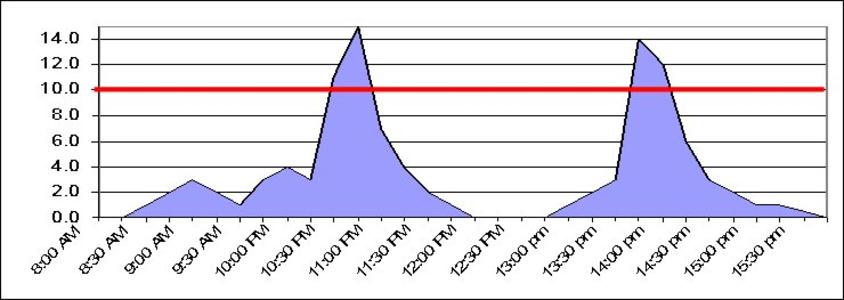
RULE OF THUMB: The LOWER the OEL, the MORE toxic the material.
The HIGHER the OEL, the LESS toxic the material.
Example: Lead has an OEL of 0.05 mg/m3 (very toxic) while Nuisance Dust has an OEL of 10 mg/m3 (less toxic).
How Do You Make Decisions About Exposure?
How toxic is the material?
A TLV® (Threshold Limit Value) is defined as a guideline designed for use by industrial hygienists in making decisions regarding safe levels of exposure to various chemical substances and physical agents found in the workplace. TLVs® are health-based values established by scientists that review existing published and peer-reviewed literature in various scientific disciplines (e.g., industrial hygiene, toxicology, occupational medicine, and epidemiology) to make a decision. TLVs® are published by the American Conference of Governmental Industrial Hygienists (ACGIH).
What is the toxic action of the material? Toxic fibers, chemicals and metals have different reactions:
- Immunological effects (Beryllium can cause Chronic Beryllium Disease)
- Specific organ effects (Coal Tar Pitch can cause Bladder Cancer, Benzene can cause Leukemia)
- Fibrosis of the lungs/lung cancer (Asbestos, Refractory Ceramic Fibers – RCF)
- Neurological (Lead)
- Some have multiple reactions
Other things to consider:
- How much of the exposure material is toxic?
- Does the exposure material contain high or low levels of toxic material?
- What is the material’s bioavailability?
- Is the toxic material bound to other materials making bioavailability low?
- What is the exposure level?
Depending upon what you are doing and how you are doing it, exposure levels are variable.
What is the route of exposure?
- You can inhale dusts (respiratory)
- you can be exposed to some chemicals through the skin (dermal)
- you can ingest toxic materials (example, not observing good hygiene when working with lead)
Understanding Exposure:
In reality, unless you are doing:
- High-volume production work that exposes you to a health hazard all day long
- You are exposing yourself to high levels of a health hazard for a brief time
- You are working with a very toxic material (which you should not be doing!)
- You are not working responsibly
You are not really at risk for an unacceptable exposure when working in a glass studio
How do you determine if a material is toxic?
Epidemiology studies: Study the past/future effects of exposures on humans. This is the best indication of toxicology.
Animal Studies: Exposure lab animal to a material under controlled circumstances. Fair to good indication of toxicology depending upon the test methodology. LD50 (ingested lethal dose, 50% population), LC50 (inhaled lethal concentration, 50% population).
Petri Dish Studies: Determine possible chemical mutagenicity in bacteria. Starting point that indicates further investigation is needed.
How reliable is toxicity data?
Depends upon the results of the study. Is it “Good Science”?
Relative Risk: Probability of outcome. Relative risk is simply the ratio of the two conditional probabilities. A relative risk equal to 1 implies that the the event is equally probable in both groups. A relative risk greater than 1 implies that the event is more likely in the first group. A relative risk less than 1 implies that the event is less likely in the first group. The bottom line: the higher the Relative Risk, the more dangerous the exposure.

Controlling Exposure:
Substitution:
Replace toxic with less toxic (this is best)
Engineering Controls:
Ventilate the area – fans, point source ventilation
Wet Methods to control dust
Personal Protective Equipment:
Respirators, ear plugs, gloves
Administrative Controls:
Spread the exposure out over time
Employee rotation
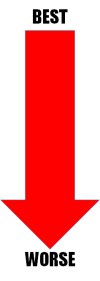
Dusts and Particulates:
- It all has to do with SIZE!
- There are many defense mechanisms throughout the respiratory system that deal with particulates of different sizes
- It is the “tiny stuff” that you can’t see that can get all the way into the alveoli of the lungs
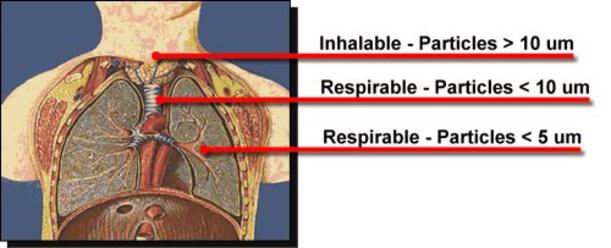
Refractory Ceramic Fibers:
- Also known as RCF, Synthetic Vitreous Fibers, Fiber Blanket
- Always read the MSDS for any fire-resistant material and check for RCF
- Current research considers RCF to be possibly similar to ASBESTOS in effects
- Some studies in animals have indicated carcinogen-potential. Other studies refute the findings.
- There are no epidemiologic studies that show RCF has caused a disease in humans.
Toxicology:
- The International Agency for Research on Cancer (IARC) classifies RCF as Group 2b (possible human carcinogen).
- The Seventh Annual Report on Carcinogens (1994), prepared by the National Toxicology Program (NTP), classified respirable RCF and glasswool as substances reasonably anticipated to be carcinogens.
- The American Conference of Governmental Industrial Hygienists (ACGIH) has classified RCF as “A2-Suspected Human Carcinogen.”
TLV: 0.2 fibers/cubic centimeter (8 hour TWA) – This is very low and indicates high toxicity
Protection:
- Wear a P95 or P100 respirator when working with RCF
- Avoid making the fibers airborne
- Always vacuum RCF – never sweep
- Buy a HEPA (High Efficient Particulate Air) filter for your shop vacuum
- When changing the bag, seal the opening with tape to prevent fiber release
- Dampen RCF with water to reduce fiber release
Kiln Wash (Bullseye)
- Main ingredients are Kaolin, Aluminum Trihydroxide, silica (>10%)
- Nuisance Dust, irritant
- P95/P100 respirator
Thin Fire Paper (Bullseye)
- Main ingredients are Cellulose, Aluminum Hydroxide, glass fiber, organic binders
- Predominately nuisance dust, irritant
- Glass Fiber – jury is out on toxicology but would be a good idea to wear a N/P95 respirators
- Keep the kiln closed when binders are burning off – this occurs between 600 – 800 deg F.
- NO SILICA, NO RCF
Silica
- Chronic effects are Silicosis, Lung Cancer, Lung Fibrosis
- National Toxicology Program (NTP) carcinogen classification: Known to be a human carcinogen
- OEL/TLV: 0.025 mg/m3 (8 hour TWA)
- Also known as: Cristobalite, Quartz, Tridymite, Tripoli
- You should avoid exposure!
- Always wear a P100 respirator when working with anything that contains silica!
- Found in kiln brick, silica flour used to make molds, some sand blast grits
- NEVER use sand for sand blasting! Use only Silicon Carbide or Aluminum Oxide for sand blasting which has a Nuisance Dust classification
- Historically found in whitening (used to be ground marble contaminated with silica)
- Never cut kiln brick dry with a power saw! Keep wet when cutting.
Always read the MSDS for any material used. Sometimes silica is a component of other products.
Nuisance Dust:
- Dust is not recognized to be the cause of any serious pathological conditions other than possible irritation
- Examples: Ground glass, sandblast grits such as silicon carbide and aluminum oxide
- However, very high exposures to nuisance dusts can cause disease. For example, extremely high exposures to baking flour has been known to cause “Flour Mill Lung.”
- TLV: 10 mg/m3
Sandblasting:
There are a variety of materials you can use for sandblasting:
- Sand: Not a good choice. Sand contains crystalline Silica. Exposure to silica can cause lung fibrosis and/or silicosis. If you have to use sand, you need to wear a P100 respirator.
- Silicon Carbide/Aluminum Oxide: Good choices. There is no toxicologic evidence that either present a significant health hazard. Both are considered to be “nuisance dusts” by OSHA. The ACGIH TLV® is 10 mg/m3 (8 hour time weighted average) for both.
Ground Glass
- OSHA classifies glass dust as a “Nuisance Dust”
- Ground glass does not cause silicosis.
- N95 respirator is recommended to limit exposure.
- Glass is made from sand, which contains silica – a naturally occurring mineral silicon dioxide (SiO2).
- Crystalline forms of silica, also known as “free” silica, can contribute to the development of silicosis under prolonged exposure conditions.
- It is important to understand the difference between glass and crystalline silica because exposure outcomes are extremely different!
- Glass is a silicate containing various other ingredients which have been melted and upon cooling form an amorphous, or non-crystalline structure.
- While silica (SiO2) is a primary ingredient in the manufacturing of glass, when glass is formed under heat, the crystalline structure is changed to an amorphous structure and is no longer considered crystalline.
- Ground glass is rarely respirable because the particle is too big.
- Always use wet methods when grinding glass! Water captures the dust.
- Sometime other chemicals are used to add color to glass such as arsenic, lead, cadmium. These are usually present in low concentrations and are bound to the glass and not readily available but could present an exposure issue under some circumstances.
Bullseye Frit:
- Powder (0.2 mm and finer)
- Fine (0.2 – 1.2 mm)
- Medium (1.2 – 2.7 mm)
- Course (2.7 – 5.2 mm)
Only powder is possibly respirable! Fine is considered “inhalable” but is too large to be of real pulmonary consideration.
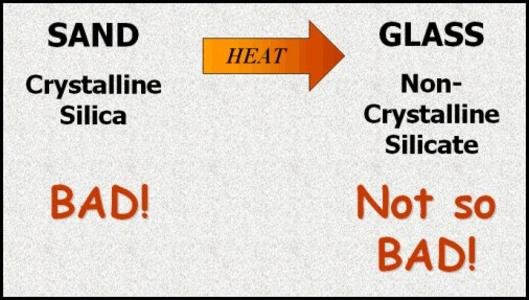
Lead
- Lead is a neurological and reproductive health hazard.
- You can bio-accumulate lead in your body.
- Can result in impaired brain function.
- Possible exposures: Soldering/lead came, using lead-containing chemicals such as paints or anti-devitrification chemicals.
- It can be present as a particulate or a fume.
- Soldering lead came for stained glass does not usually present an inhalation hazard if the area is well ventilated and you are using an iron and not a torch. With normal soldering, you are melting the lead at temperatures that are NOT hot enough to create a fume.
- Lead fume is the inhalation exposure issue. Fumes are very small respirable particulates that are made with heat. Liquid chemicals give off vapors.
- You can collect lead residue on your hands which can cause an ingestion hazard. Ingestion is the leading cause of lead over-exposure. Do not eat, drink or smoke when working with lead-containing materials.
- If you are concerned about lead exposure, your physician can perform a blood lead test. Normal levels are < 40 µg/100 grams blood.
- Avoid exposure by ventilating the area when soldering, especially if using a torch instead of an iron. Open a window and turn on a fan! Wash your hands thoroughly when finished working with lead. There are specific products for this purpose.
- Use a P95 or P100 respirator when concerned about lead exposure.
Does glass firing in a kiln let off toxic fumes?
- Not to any significant amount because with most glass there is nothing to burn off or volatize.
- If you are fusing lead crystal (PbO), the lead content is very low and in a closed kiln, exposure will be minimal.
- If you do this on a regular basis, you kiln needs to be ventilated and you should wear a P95/P100 respirator when the kiln is open and glass is above 500°F.
- Always make sure you know the lead content.
GLASS AND FOOD SAFETY:
Lead Crystal:
- Acidic foods such as orange or grapefruit juice, tomato juice, coffee, tea, tomato-based foods such as spaghetti sauce, wines and vinegar-containing foods cause more lead to leach into the food than do non-acidic foods such as water or milk. More lead leaches into hot food than into cold food.
- Exposure is minimal, but present.
- However, any glass I make where I used any lead product (paint or over-glaze) I labeled as containing lead. I do not use lead-containing materials on any functional glass.
- You can always fuse clear glass over any glass that contains a toxic material to seal it.
Iridized Glass:
- Tin Chloride – low toxicity. Large oral doses may cause irritation to the gastrointestinal tract. The Lethal Dose is pretty high (Oral rat LD50: > 20 gm/kg). This means that 50% of the test rat population died when fed 20 grams Tin Chloride per kilogram of body weight. This means that if you weighed 200 pounds, you would have to eat almost 2 pounds!
Dichroic Glass:
- Aluminum Oxide, Silicon Dioxide, Tantalum Oxide, Titanium Dioxide, Zirconium Dioxide – low toxicity.
- No ingestion issues as material is tightly bound to the glass.
PREGNANCY
Women who are pregnant or nursing should consult with their OB/GYM prior to kiln working!
- Heat: Scientific literature does not reveal any adverse effects in relation to working in hot environments. However, excessive heat should be avoided.
- Lactation: Exposure of a lactating woman to chemicals may also exposure the child. No danger has ever been shown to the child if chemical exposures are kept to less than the TLV, Women should avoid toxic metal exposure.
- Exertion: Pregnant women should avoid excessive exertion.
- Lead: There are many reports in the medical literature of lead exposure causing spontaneous abortions, premature deliveries and congenital abnormalities at relatively low fetal blood lead levels. Women who are pregnant or nursing should avoid all lead exposure! Women who are considering pregnancy should minimize lead exposure.
- Cadmium: Both a male and female reproductive issue. Exposure should be minimized.
- Carbon Monoxide: Relatively high exposures may result in decreased birth weight and increased mortality of offspring. Make sure you are working in a well ventilated area.
